|
Related FAQs: Turtles, Turtles
2, Sliders, Turtle Identification, Turtle Behavior, Turtle Compatibility, Turtle Selection, Turtle Systems, Turtle Systems 2, Turtle Feeding, Turtle Disease, Turtle Disease 2, Turtle Disease 3, Turtle Reproduction, & by Species:
Musk/Mud Turtles, Other
Sliders/Emydids (Pond, Painted...), Softshells, Snapping Turtles, Mata Matas, Tortoises, & FAQs on Red Ear Sliders:
Sliders, Sliders 2, Red Eared
Slider Identification, RES
Behavior, RES Compatibility,
RES Selection, RES Systems, RES
Feeding, RES Disease, RES Disease/Health 2, RES Reproduction, & Other Reptiles, Amphibians,
Related Articles: Red Eared Slider Care by Darrel
Barton, So your turtle has the Flu? Recognising and
treating respiratory infections in pet turtles by Neale
Monks,
Freshwater
Livestock,
Turtles: ID/Physical Attributes
(i.e., Species ID, Aging, Sexing)
Part 2
To: Part 1,
Part 3
|
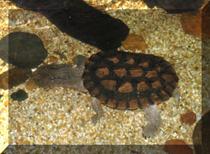
|
| by Sue Garrett |
|
Is Eastern Red Bellied Turtle considered a
Plymouth RB Turtle?
(Original heading: Endangered or
Not?)
I'm confused about the endangered species
list. Is and EASTERN RED BELLIED turtle considered a PLYMOUTH RED
BELLIED TURTLE? because the Plymouth ribs on the endangered list and is
a sub species of the eastern rb. can you please set me straight I'm
confused.
>> This has been in our inbox for a few days, so I think none of
us are so sure. There is an easy way to find out. You can call your
local USFW (US Fish and Wildlife Service) office, and they should be
able to help you with your query. They have a website, but I am not
sure what state you are in to find you the local number. Good Luck,
Oliver
|
RED BELLIED
TURTLES
Genus:
Pseudemys
·
Carapace greenish to dark
brown or black with yellowish, orangish or reddish vertical
markings along the sides
· Plastron varies from
orange to reddish
· Head, neck and legs
marked with yellow stripes
· Adults average 10-15 in
shell length
· Females larger in size
but males have longer claws, thicker tails and their cloaca is
farther from shell
|

|

|
|
CHICKEN
TURTLES
Deirochelys
reticularia
·
Pear-shaped, olive to
dark brown carapace with a net-like pattern
· Plastron typically plain
yellow
· Broad yellow stripe down
front of fore-legs
· Unusually long striped
neck but not as long as snake-neck
· Adults average 4-10 in
shell length
· Females larger in size
but males have longer claws, thicker tails and their cloaca is
farther from shell
|
|
Is It a Chicken, or a Turtle? No! It's the
Eastern Chicken Turtle
Hi I've just recently brought an
eastern long neck turtle. It's about 2 years old. I was
just wondering how much food and what food is the best to feed him.
< You probably are referring to an Eastern Chicken turtle. This is
an aquatic turtle that does well on meal worms, earthworms, crickets,
king worms, trout chow, fish and commercially available turtle food. A
varied diet is best. Feed him once a day so that most of it is gone
after a couple minutes. As the weather warms up then his metabolism
will increase and he will need to be fed a little more and maybe a
couple times a day.-Chuck>
|
MAP
TURTLES
Graptemys
geographica
· Carapace is olive to
olive brown with reticulate pattern of narrow yellow lines; most
have a keel running down the middle
· Plastron is pale
yellow
· Head, neck, legs and tail
are olive brown patterned with thin lines
· Head has elongate yellow
blotch on each side of head just above ears
· Adults average 4-11 in
shell length
· Females larger in size
but males have longer claws, thicker tails and their cloaca is
farther from shell
|
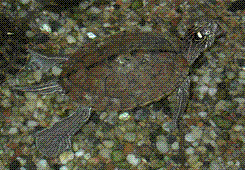
Darrel Barton Image
|
Keeping, Feeding, Sexing Map Turtles
3/28/07
Hi there. We have two Mississippi Map Turtles that
we bought as hatchlings in November of last year (2006). My
first question relates to how much we should be feeding
them. We have two different types of pellets but haven't
managed to get a definitive answer of roughly how many we should be
feeding them so we have no idea if we are massively over/under feeding
them. At the moment we feed them every day and give them
approx. 8 pellets each - they gobble these down in a few seconds which
makes us think they need more but I'm sure I remember being told
that they should only have a few each? I'm very worried
as I read somewhere that if you over-feed them, their shells can crack
which we obviously don't want to risk happening.
The pot says to feed them as many as they will eat in five min.s but
with our two that would be LOADS - is that right?! We have
tried them with other food as well as the pellets but they don't
seem to be very interested - they will occasionally eat freeze dried
shrimp but won't touch live river shrimp or most other things.
< Feed your turtles three to four times a week. Keep feeding them
until their appetite starts to slow down indicating that they are
getting full. Then remove all the uneaten food. When they are hungry
again they will be very active and searching for food. this is a sign
that they are hungry and can now be fed again. try the new foods after
not feeding them for a few days. Hungry turtles will try anything.
Hatchling turtle food is best with treats of washed earthworms and
insects.>
My second question relates to the sex of the two turtles. At
what age should we be able to tell what sex they are?
< At about 4 inches you should be able to se some of the different
sexual characteristics.>
I know the females will eventually be bigger but when would we notice a
big difference between
them if they were different sexes? One has always been
larger than the other but we don't know if that is just "one
of those things". Also, please could you tell me any
other signs that will enable us to tell them apart and at what age we
should be able to notice them?
Many thanks. Adele Davis
<When two turtles are kept together one always seems to be dominant
and get most of the food. This dominant turtle always seems to grow
faster regardless of the sex. This can make determining of the sexes
difficult for a while, but eventually the female will grow larger that
the male.-Chuck>
What Kind of Turtle is it?
8/23/05
My friend just found a small turtle, but cannot
find out what type it is. It is either dark green or black
with yellow-green stripes all over its body and shell. Also it has a
flat yellow-orange stomach. It has three triangular bumps on its
shell. It has a tail and webbed feet with claws. If you know what it
is, please tell me what it eats. Also, the place where she
found it is under construction. Where would you suggest she
release it?
< Sounds like you have a map turtle. They are an aquatic species
that live on invertebrates, fish, plants and just about anything else.
It could be released in a stream , river or creek away from human
habitations.-Chuck>
|
SIDE/SNAKE NECK
TURTLES
Genus:
Chelodina
· Long neck is distinctive
feature, in some cases as long as carapace; bends sideways to
tuck in its head
· Carapace flattened,
broad, brown with black-edged scutes
· Plastron is cream colored
with distinctive black lines/seams
· Adults get up to 10
average shell length
· Females larger in size
but males have longer claws, thicker tails and their cloaca is
farther from shell
|
|
Aging and Sexing Side Neck
Turtles
(Original heading: Keeping and Breeding
Sideneck Turtles)
Hi there. I tried finding an answer for this on
the other questioners' queries, but their answers either
weren't specific enough or didn't exist. I am the proud owner
of an African Side Neck turtle, named Elijah, whom
I've hesitantly labeled a male. Unfortunately, I'm not entirely
sure of my turtle's gender or age. When I bought him he was in a
tank at Petco with other ASN's and some RES's. However, I was
not informed of his age or gender by the shopkeeper. Is sexing in
ASN's similar to sexing in RES? With long claws and long thin tails
meaning it's a male (I read that that only applies after five years
old)? Or does that not apply?
< In general male turtles tend to be smaller than females of the
same age and some species do have longer front claws. Look at the belly
of the turtle. Males usually have and indented belly area to mount the
female during mating. Females usually have a very flat belly
area.>
And how might I tell my turtle's age by looking at him? He's
about six and a half inches long, if that helps.
< Very difficult to determine an exact age.>
I'm asking all this, because I'm intending to breed him/her
when he/she reaches sexual maturity, so perhaps you might be able to
tell me when that might be for this breed, as well. Thanks a bunch!
Stephanie
< Breeding herps is usually not too easy to do. I would recommend
that you go to Kingsnake.com and get in contact with some serious
turtle and tortoise clubs to see if you really want to get into this
area.-Chuck>
|
YELLOW-HEADED AMAZON
TURTLES
Podocnemis
unifilis
·
A type of side-necked
turtle
· Brown or black oval
carapace
· Yellow spots on sides of
its head
· Adults can get up to 17+
inches
· Females larger in size
but males have longer claws, thicker tails and their cloaca is
farther from shell
|
|
|
SNAPPING
TURTLES
Genus:
Chelydra
Shown on right: Common
Snapping Turtle
· Tan to dark brown or
black colored serrated carapace with row of spikes running down
the midline
· Plastrons very small
leaving much of extremities exposed
· Yellowish color neck,
legs and tail; head darker in color
· Hooked beak, long, strong
tail with a row of ridges; heavy claws
· Shells of adults average
7-31+ inches long
· Adults can weigh up to
249 lbs; males larger than females
|
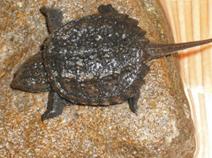
|
|
A common snapper; not an alligator turtle
9/30/09
(Original
heading: Care of a 2 in. alligator snapping turtle
9/30/09)
Hi,
<Hiya - Darrel here>
My granddaughter found a small black turtle with a beak and spiny
back on September 26 in the middle of a barrier beach of Smith
Point County Park on Fire Island, Suffolk County New York. My
husband had spotted a similar turtle a few days earlier in the
middle of the camp ground road and he moved it to the marshy area
on the bayside of the barrier beach. We feel we rescued it but
want to know what to do now!
<That would be a long way out of the range of an alligator
snapping turtle, but within the normal range of a common snaper,
Barbara. Alligator snappers are common only to the drainage basin
around the Mississippi river. Assuming there's no chance that
it's an escaped pet or even a sea turtle (Sea turtles have
flippers and no claws)?? What I'd really like at this point
is a couple of photos, even if just from a phone camera. Face,
side and from front & above would help clear up a number of
questions>
We have it in a clear plastic container with wet beach sand, a
clump of wet kelp and a sea sponge and a clam shell to provide
habitat and a receptacle for fresh water and food.
<None of those would be common environment of either snapping
turtle>
We offered bits of cooked chicken ,chopped meat and lettuce at
different times without much interest.
<Based on it's environment it probably is in no mood,
maybe even no condition to eat>
It has been active at times, climbing to the top of the sponge
but is mostly burrowed into a thin layer of sand under the kelp.
Aside from removing the old food and 'poop' and
occasionally peeking under things to assure that it is alive we
haven't disturbed it much. Now the question: is it keepable
as a pet for an 8 year old under supervision, or should we
release it and where?
<Well whether or not it's keepable is dependent on a great
number of question unanswered. Snapping turtles are notorious for
biting hard and having short tempers, so they don't make a
good lap pet. But with that said, even a Red Eared Slider can
inflict a nasty bite if handled incorrectly -- so really it all
depends on the level of maturity of the 8 year old. Turtles are
good pets to house, care for and observe, but not to play
with.>
<As far as the other thing ... NO!!! NO!!! We never EVER
release any animal into the wild, even when it's with our
best intentions.
Territories, sub species, communicable diseases ... just a few of
a hundred reasons. If he survived at all, he'd possibly
contaminate others, so we never ever release into the
wild.>
<Once we find out what it is -- send pics!!! -- we'll
decide what to do.
In the mean time, the link below will give you some basic
information.>
<All snapping turtles are more aquatic than sliders. While
they do it less often, they DO haul out & bask and still need
a warm dry place to soak up some UV rays ... so for the purpose
of the time being only, read the enclosed link and set up a basic
environment to specifications. Meanwhile send pics and we'll
go from there>
Any help or advise you can give would be most appreciated!
Sincerely Grandma
< http://www.wetwebmedia.com/FWSubWebIndex/RESCareBarton.htm>
Re: care of a 2 in. alligator
snapping turtle 9/30/09
Hi Barbara,
Yes, what you have there is the Common Snapping turtle, Chelydra
serpentina. They make interesting pets but frankly they are a bit
dangerous. The rules for keeping a snapping turtle are that you
never, ever, ever ... for any reason .... put anything you care
about anywhere near the front half of that animal. They're
not actually mean ... but they have a very limited tolerance for
anything moving around in front of their face before they'll
strike out at it -- and once they grab a solid hold, they have
the ability to hang on for very long periods.
A 20 gallon aquarium (or similar container) with shallow water
(no deeper than 4 inches) and a small place to haul out and dry
off under a basking light is all that is required initially. If
it's not an actual aquarium, make sure the sides are high
enough that it can't climb. Feeding is simple -- Reptomin
food sticks or Koi Pellets from the local pet store (same
ingredients, just cheaper) will provide a fully balanced
diet.
They're interesting, low maintenance pets but on the other
hand, they're very hardy animals that, with even minimal
care, can grow to an extremely dangerous size in just a few
years. So my advice on keeping it? ...
maybe .. maybe not. But if you decide not, inquire around your
city for a turtle and tortoise club to find someone with the
desire and experience and please just don't release it.
Best wishes
Darrel
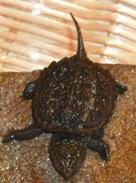
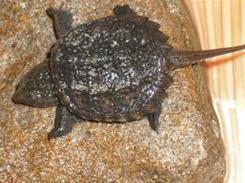
|
|
what kind of turtle and how old is
it 6/27/09
I know the attached is not a
snapping turtle but I have never seen anything this big that was
not, what is it and how old.
<It's a Common Snapping Turtle (Chelydra serpentina).
Alligator Snapping Turtles (Macrochelys temminckii) generally
have a row of spikes along the midline of the shell running along
the spine, whereas Common Snapping Turtles do not. As for age, I
have no idea. Captive specimens routinely live well over 20
years, and the record is around twice that. Given the apparent
size of this specimen, it is probably going to be well over ten
years old.>
found in the Metro North Parking lot, in June, 2009 land put on
side of road and let go. /Westchester County, NY
<Cheers, Neale.>
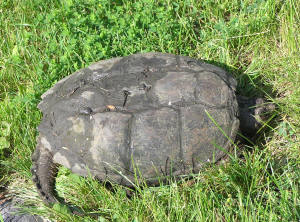
Re: what kind of turtle and how old
is it 6/27/09
I would never have guessed a snapping turtle. Thank you for your
very prompt reply. John H Vargo, Publisher,
Boatingonthehudson.com and boating on the Hudson & beyond
mag.
<Happy to help. Cheers, Neale.>
|
|
MUD
TURTLES
Genus:
Kinosternon
Shown on right: Common Mud
Turtle (Kinosternon subrubrum)
·
Carapace is generally
pattern-less and varies from yellowish brown to olive or
black. Its smooth, unserrated and drops abruptly
behind.
· Plastron color ranges
from yellow to brown.
· Head is usually brown
with some yellow mottling; sometimes there are two light lines on
each side of head and neck.
· Skin is brown to olive or
grayish and may exhibit some markings
· Shell length of most
adults averages 5; some species up to 9
|
|
|
Turtle identification request -
6/20/08
Dear Crew,
<Hiya Colin, Darrel here today>
Any info you can provide is appreciated.............I've been
through many websites and can't seem to find a good match. he
was found in a lake in central Illinois. he has a distinct ridge
down the center of his shell (does this rule out mud turtle?) has
small yellow dot-like marks around the 'skirt' of his
shell edge that you can see from the top bottom of shell has
yellow splotch towards center, darker perimeter yellow line
markings on his neck and limbs, subtle
Thanks!
Cj
<Your pictures are large and well lighted, but focus is a bit
of an issue. It might be better if you pulled back a bit and
allowed the autofocus a bit more room to work ... but with that
said it looks like the common mud turtle (Kinosternon subrubrum)
to me. Take a look at this link, down near the bottom is a 2 yr
old Mud Turtle (retracted, sorry to say) but compare this to
yours and see if we nailed it>
http://www.xupstart.com/wwm/
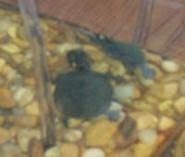
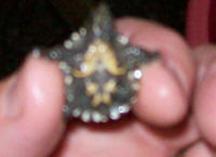
turtle identification request -
6/21/08
Any info you can provide is
appreciated.............I've been through many websites and
can't seem to find a good match.
he was found in a lake in central Illinois he has a distinct
ridge down the center of his shell (does this rule out mud
turtle?)
<Mmm, no... this looks like a Kinosternon subrubrum to
me...>
has small yellow dot-like marks around the 'skirt' of his
shell edge that you can see from the top bottom of shell has
yellow splotch towards center, darker perimeter yellow line
markings on his neck and limbs, subtle
Thanks!
Cj
<Is one of these:
http://www.chicagoherp.org/herps/species.htm#turtles
Bob Fenner>
|
|
MUSK
TURTLES
Genus:
Sternotherus
Shown on right: Common Musk
Turtle
· Named because of ability
to release smelly musk from two glands on each side of its
body
· Carapace color ranges
from drab olive to grey-brown to blackish
· Unmarked plastron ranges
in color from yellow to brown
· Skin is gray to black;
head has pair of yellow or white stripes
· Most adults range in size
from 3-4; some species up to 6
|
|
|
MATA MATA TURTLE
(Photo: DFW
Aquarium)
Chelus
Fimbriatus
·
Related to side-necked
turtles but with some different attributes
· Most striking features
are triangular shaped head, and a nose with a tube extension that
allows them to breathe underwater
· Carapace is usually black
or brown with some orange color; scutes can appear rough; three
keels run down the length of it
· Plastron ranges in color
from a light yellow to a deeper brown shade
· Skin varies from an
orange-brown to a grey-brown tone
· Adult shell length can
get up to 18 long
|

|
|
SOFT SHELLED
TURTLES
Family:
Trionychidae
· Many genera/species in
family; all different in terms of identification and
care
· Common physical attribute
they share is a carapace that lacks scutes and is leathery and
pliable, more like thickened skin
· Carapace colors vary from
pale to dark brown, gray or olive-yellowish; tends to match the
sand or mud color where its from
· Plastron color is very
light, either white, cream or yellowish
· Webbed feet, long necks
and piggish-like nose they use as a snorkel
· Adult size ranges
dramatically depending on species from several inches to several
feet; females larger than males
|
|
|
PIG NOSED RIVER
TURTLES
Carettochelys
insculpta
· Distinctive from, but
related to, the soft shelled family
· Most aquatic of all
non-marine turtles with paddle-like forelimbs/flippers
· Carapace is usually grey
or olive in color with a leathery texture; has a domed bony
carapace instead of flat plate like other softshells
· Plastron color is very
light, either white, cream or yellowish, and is solid not soft
like other softshells
· Has a blunt pig-like
snout for a nose
· Carapace length can grow
upwards of 22 inches
|
|
Pig Nosed River Turtle characteristics
4/16/07
(Original heading: Pig Nosed River Turtle
Questions, sys. 4/16/07)
Hello guys, I hope you can bear with me and try to
answer my questions, I am really sorry I have so many questions and
taking up your precious time. Really appreciate your help and time and
efforts! Thank you in advance!
My pig nose turtle has been really restless for the past month,
swimming from one end to the other in the tank and flapping water
furiously but stopped once I go over or pat it on its head. Last time
it (I am still not sure of its gender, I know a long tail and long
nails at front flippers should indicate a he but I am not sure how long
exactly is considered long enough.) used to calm down after I fed it
but food doesnt work anymore so I really dont know what my turtle is
asking for now. I have seen similar questions posted in the forum but
the replies did not directly explain this behaviour. I have varied the
diet but it didnt help. I have kept the turtle for years and this hasnt
happened before. Theres no hiding place for my turtle and I will try to
get one because its difficult to find a cave-like structure big and
light enough for the glass tank. My turtle is about 22cm from head to
tail and 17cm in width.. Do you know how old it is?.
< They grow very slowly and no literature is available on the growth
rate of this turtle.>
When I bought it, I believed it was just a hatchling, no bigger than
about 10cm from head to tail.
And is it also 80F for the water temperature for Pignose turtle?
< That sounds like it is in the range for this species.>
Can you tell me how many Celsius degree is 80F?
<Around 27 C.>
Should the basking area be higher in temperature?
< Generally the basking areas are always higher so the animal can
increase its body temp to fight disease and to aid in
digestion.>
And aside from the basking light, do I also need another lamp for the
tank?
< You need heat and another lamp to provide the proper lighting
spectrum for vitamin development.>
Are these two kinds of lamps different?
< Usually yes although some lamps can provide both heat and some UV
radiation.>
And should I keep the lights on during the day and off at night?
< Yes.>
I also dont have a basking area for it, because the water level of the
tank is about three quarter full and I have no idea how to build a
basking area so high above the water. If I keep the water level lower,
will it deprive my turtle in terms of swimming space?
< Yes try and build a shelf on which the turtle can get out on.
ZooMed makes a Turtle Dock for just such a situation but it is not big
enough for a turtle like yours.>
If I put it out in a tub for basking, is half an hour enough?
< Only the turtle itself knows how long it needs to bask.>
It doesnt really get a lot of direct sunlight because I stay in a flat
and have no garden or porches or anything in kind.
Do I need to add a bit of water in the tub?
< This is a very aquatic turtle that in the wild would spend hours
swimming around in a big river. If you are going to confine it to a
tube then I would still and try to provide as much swimming are as
possible.>
So sorry I have so many questions. I hope you can answer to them all.
So sorry to take up so much of your time and efforts, really appreciate
any help given!.. Thank you soo soo much!
Lost and frantic owner, Jaz Singapore
< This is a very rare turtle and I believe on some CITES lists too.
Very scarce and very expensive in the U.S. The cool thing about these
turtles is they look and act like ocean sea turtles but are found in
fresh water instead. They get pretty big for a pet turtle. The shell
can get up to almost 20 inches and they can weigh up to 35 lbs. There
is very little known about these turtles and literature is scarce.
Since they get soo big and are very aquatic I would try and give them
as much swimming space as possible. They may come out to bask
occasionally but I don't think they will use a basking spot very
often. Some people in the US that are fortunate enough to have this
turtle have told me that they are totally aquatic and don't require
a basking spot. But I would still provide UVB and UVA over the basking
site to cover my bases. The basking site should still be around 85 to
90 F. The water temp should be around 80 F. The diet may need to be
modified for minerals that it may not be getting. Try adding a few
vitamins to the food to see if that helps settle him
down.-Chuck>
To: Part 1,
Part 3
|
|

